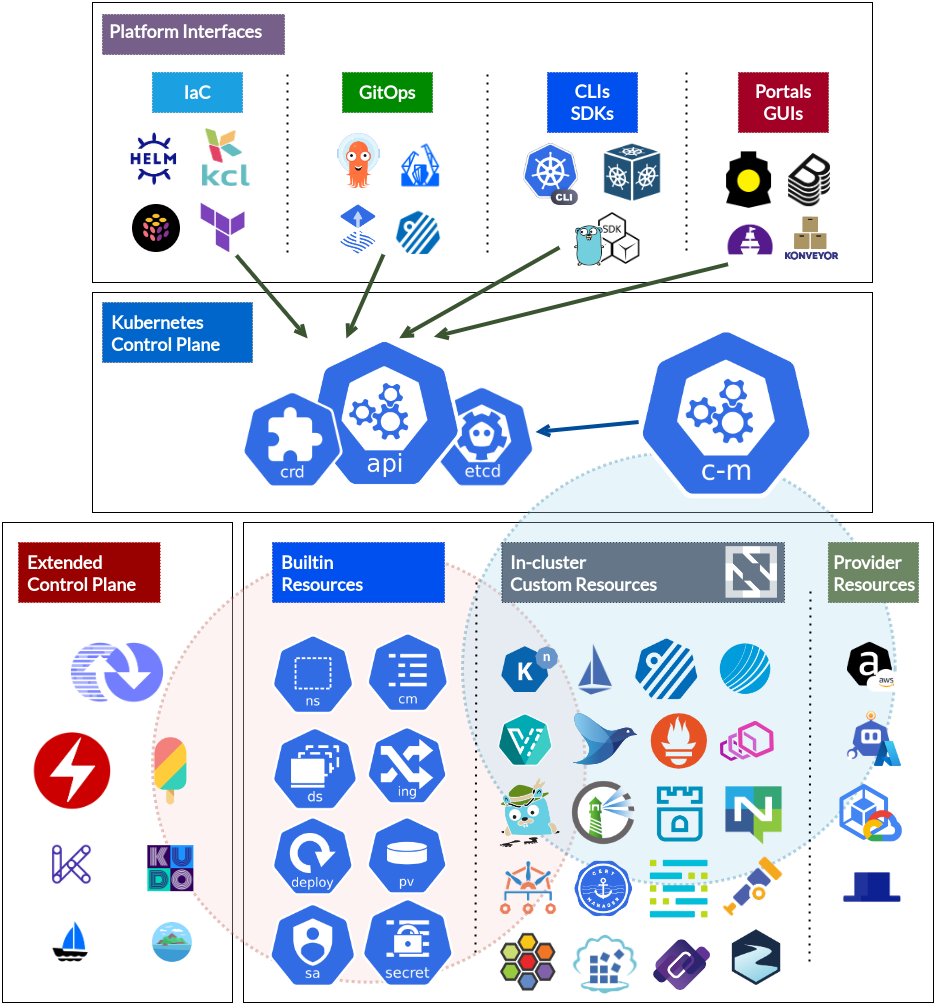Orchestrate platforms with Kubernetes

Sometimes an obvious idea still deserves to be stated explicitly. One such idea is that the Kubernetes API and its ever-growing ecosystem of extensions and extensibility frameworks is an ideal open, portable orchestrator for today’s emerging internal enterprise developer platforms. In this post I’ll explain why that is and what it means to adopt Kubernetes as orchestrator.
To set the stage, our industry is currently intrigued by the value of internal cloud-like platforms that provision and manage high-level capabilities for products and applications on demand. The term “orchestrator” is often used to describe the central “brain” of these platforms; such an orchestrator is a set of controllers that calculate and execute workflows as required to manage high-level capabilities and components for applications and maintain those capabilities in their expected, desired state.
Let’s reflect further on what orchestrators are. In fact the term has been used for a while to describe resource managers like Azure Resource Manager (ARM), Hashicorp Terraform and even AlibabaCloud’s Resource Orchestration Service; as well as Linux container managers like Apache Mesos, Docker Swarm and even our beloved Kubernetes. What is common to all these? The aspect they share is that they receive workload descriptors and resource requests centrally then coordinate and route those requests to be fulfilled by many other resource and service providers. That is, orchestrators coordinate request fulfillment across many service providers.
For example, submit a collection of resources to Azure’s Resource Manager and it in turn will call a Storage resource provider (RP), a Database RP, and many other Azure and third-party RPs to complete your request. Apply a collection of resources via terraform apply and it uses some of its many providers to provision those resources. Or last but not least, submit a bunch of Kubernetes resources to a Kubernetes API server and it will delegate them to its many built-in and custom controllers to manage.
Kubernetes is an orchestrator
As I’ve mentioned in other posts, Kubernetes emerged as a way to coordinate and run containers across many Linux machines, but the real value of Kubernetes is that it’s a de facto open, portable, standard API framework for software-defined - aka cloud - infrastructure; that is, Kubernetes is a framework for automatable infrastructure and platform capability management. Because Kubernetes offers this we can and should use it as a framework for building platform orchestrators.
That’s the central idea here so let me repeat it: we can and should use the Kubernetes API as a framework for building platform orchestrators.
Why? First, Kubernetes and its patterns and tools is an open standard for infrastructure and platform management. Perhaps it took us a while to get comfortable with it but at this point Kubernetes is familiar to most experienced industry practitioners, and tools and practices like kubectl and GitOps are broadly understood. It’s a completely open standard too - its source is licensed openly and managed by a foundation, new specs are developed openly with input from many companies and individuals, and managed implementations that conform to those specs and standards are available from many providers. So building on Kubernetes is a reliable investment.
Next, a vast array of open source projects are embracing the pattern of orchestrating their own published capabilities and internal components via Kubernetes controllers. Almost all CNCF projects are installed by deploying controllers in Kubernetes clusters; and then used by declaring those controllers’ resources via Custom Resources (from “CRDs”). So it’s natural for companies seeking to build their own thinnest viable platforms on the shoulders of open upstream projects to adopt Kubernetes too.
Last, and far from least, a number of frameworks are now available that make building an orchestrator (aka a “control plane” or “internal platform”) on Kubernetes straightforward. Platform engineers don’t have to rewrite or even recompile Kubernetes to extend it, they simply need to learn and leverage Operator Framework, Crossplane, KUDO, Kratix or tomorrow’s newest controller management framework.
The ubiquity and openness of Kubernetes and its ecosystem are key reasons it should be your first choice as a platform orchestrator.
What does that mean?
So what does it look like to use Kubernetes as your platform orchestrator? Let’s start with the following graphic:

First, let’s again define a platform orchestrator: a system that executes workflows to provision and/or maintain platform capabilities and software-defined infrastructure. Kubernetes acts like an orchestrator and runs such workflows when triggered by resources submitted to its API server: once admitted, Kubernetes controllers discover new and changed resources for types under their management and execute tasks to bring those resources to their declared desired state.
For example, if a Deployment resource is submitted to Kubernetes, a Deployment controller ensures one pod template per desired replica is rendered and instantiated in the cluster. If an Ingress resource is submitted, a network controller ensures routing tables in nodes and cloud services are configured to route traffic as desired.
But as we mentioned above, Kubernetes can handle much more than its built-in resources like Pods, Services and Volumes. For example, today’s broad collection of CNCF projects offer themselves primarily as extension controllers to Kubernetes too. Want a virtual machine instead of a container? There’s a controller - KubeVirt - and custom resource for that. Want a certificate management system? Try cert-manager. Looking for Kafka infrastructure? Try Strimzi. Need a directory and OpenIDConnect system? Choose from Dex or Keycloak.
And Kubernetes’ usefulness as a general orchestrator and control plane doesn’t stop with cluster-internal resource types. Using the likes of AWS Controllers for Kubernetes, Azure Service Operator, and Google Cloud Config Connector, internal platforms can offer to provision and manage provider-managed services using the same paradigms as internal, in-cluster resources.
What does that mean to you?
The previous section describes the robust collection of pieces and building blocks available today for building a platform orchestrator on Kubernetes. Indeed some intrepid organizations are already building platforms and orchestrators from this hodgepodge of pieces - installing each controller in its own way while gradually establishing common standards and patterns. These systems often include and are even sometimes equated with Kubernetes-native delivery systems that accompany them like GitOps via ArgoCD or Flux.
But the truth is another component is needed to consistently coordinate the collection of controllers in Kubernetes that make it a complete platform; and several frameworks are emerging and maturing to enable this - find them in the above graphic as part of Kubernetes’ “extended” control plane. The first and perhaps still most popular controller manager is Red Hat’s Operator Framework, which provides not only tools to curate and create new controllers but also a “contoller of controllers” known as Operator Lifecycle Manager to package and deploy controllers into clusters and keep them up to date.
Another popular controller manager framework is Upbound’s Crossplane. Crossplane includes a system for managing extension controllers - known in Crossplane as providers - as well as a higher-level type composition system known as “composite resource definitions” (“XRDs”) to work with new resource types from those providers. Other frameworks for managing a collection of Kubernetes controllers are Kratix, KUDO and KubeVela. Notably, each of these frameworks also offers a catalog of compatible extensions, many of which are also listed in CNCF’s syndicated ArtifactHub. The primary catalogs for each framework can be found in the following table.
| Framework | Catalog |
|---|---|
| Operator Framework | Operator Hub |
| Crossplane | Upbound Marketplace |
| Kratix | Kratix Marketpace |
| KUDO | KUDO Operators |
| KubeVela | KubeVela Catalog |
The point of this section is to emphasize that if you already do or plan to use Kubernetes as an orchestrator you should strongly consider choosing a framework to help build and manage all those Kubernetes extensions and controllers consistently. Some forward-thinking organizations may have started building such a framework themselves, gathering standards and templates for installing Helm charts, running scripts and implementing other practices for deploying and managing controllers. Whether you’ve already built something yourself or not, if you’re building a platform on Kubernetes I recommend evaluating, adopting and helping evolve one of the open source frameworks mentioned above for all of our benefit.
Now what?
In conclusion, Kubernetes stands waiting as a de facto open, standard, hybrid orchestrator for your internal platforms. Choose a controller manager framework, choose some capabilities and start building your platform on Kubernetes today!